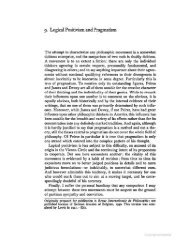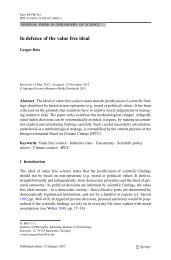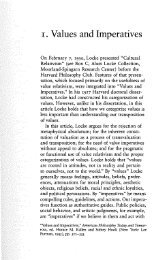Ethnographic Research - Matthew J. Brown
Ethnographic Research - Matthew J. Brown
Ethnographic Research - Matthew J. Brown
- No tags were found...
Create successful ePaper yourself
Turn your PDF publications into a flip-book with our unique Google optimized e-Paper software.
ETHNOGRAPHIC DATAEXHIBIT 13.4 Evaluative and Reformist <strong>Ethnographic</strong> ClaimsEthnography of Speaking and/or Ethnography of Communication:How do members' use of communication resources or knowledge deal with power, or privilege some members' interests at the expenseof others members' interests?1. "The Internet is not a placeless cyberspace that is distinct and separate from the real world; ... People in Cybercity areinvesting as much effort in maintaining relationships in cyberspace as in other social spaces" and "are widening theirrelationships, not weakening them" (Carter, 2005, p. 148).2. "Our findings suggest that grammar and language instruction needs to be reconceptualized in order to promote languageideologies that are reflective of current research in linguistics, that help students become more proficient in written StandardEnglish, and that build upon students' linguistic experiences in positive ways" (p. 123).3. "Invisibility shapes (and is shaped by) processes of stigmatization, 'street smarts' as enacted by youth, and 'Mayberry' and 'notin my backyard' community discourses .... The disappearance of youth without homes simultaneously serves and underminesvarious stakeholders" (Harter, Berquist, Titsworth, Novak, & Brokaw, 2005, p. 305).Autoethnography:1. "Inferential sexism and racism are endemic to U.s. higher education and classrooms and are as dangerous as overt forms ofsexism and racism because they are harder to identify, and more naturalized and acceptable" (Patton, 2004, p. 60).2. Autoethnography can extend previous studies that frame "CMC or computer-aided instruction (CAl) as Iiberatory withoutaccounting for the cultural and political realities of the classroom" (A. F. Wood & Fassett, 2003, p. 287). Second, "technology isnot simply present in the school. Rather, it schools us" (A. F. Wood & Fassett, 2003, p. 287).(3. Autoethnographic research "highlights the need among practitioners to correct ourselves, as much or more than the need forus to correct them (offenders)" (Williams, 2006, p. 23).Performance Ethnography:1. "Artwork themed on the activities of the North American cowboy and the North American west has a marginal statusin contempora ry art worlds despite its iconic place in popular culture. The expression of such a social distinction is embodiedin the performative practices of institutions that collect, legitimate, or exhibit such work" (Rusted, 2006, p. 115).2. Public performances of interview data from uninsured or underinsured California workers can"engage readers, the public,and policymakers to address difficult issues associated with the lack of health insurance" (Saunders, 2008, p. 528).Now let's turn our attention to the different sourcesand strategies for ethnographic data collection andanalysis.<strong>Ethnographic</strong> DataIn this section, you will learn more about the majorsources for ethnographic data collection, includingparticipant observations, interviews, and analysis ofarchival documents and cultural artifacts. We help youconsider the procedures you can use to collect thesedata, from gaining access to selecting key informants,taking field notes, and exiting the field. Finally, you'lllearn more about the basic strategies for analyzing ethnographicresearch data: transcribing interviews, codingand reducing data, applying descriptive frameworks toanalyze communication norms and rules of interaction,and writing case studies. All of these ideas will build onthe concepts you learned in chapter 5, «What Counts asCommunication Data?"Sources for Data CollectionTwo of the defining characteristics of ethnographicresearch are that «the investigator goes into the field,instead of bringing the field to the investigator"(Schwartzman, 1993, p. 3) and that data are representedfrom the view of the participants (Stablein, 1996).Participant observation is the process of watching andlearning about the setting and participants while youare participating in the daily realities you are studying(Lofland & Lofland, 1995; Spradley, 1980). Intenliews






